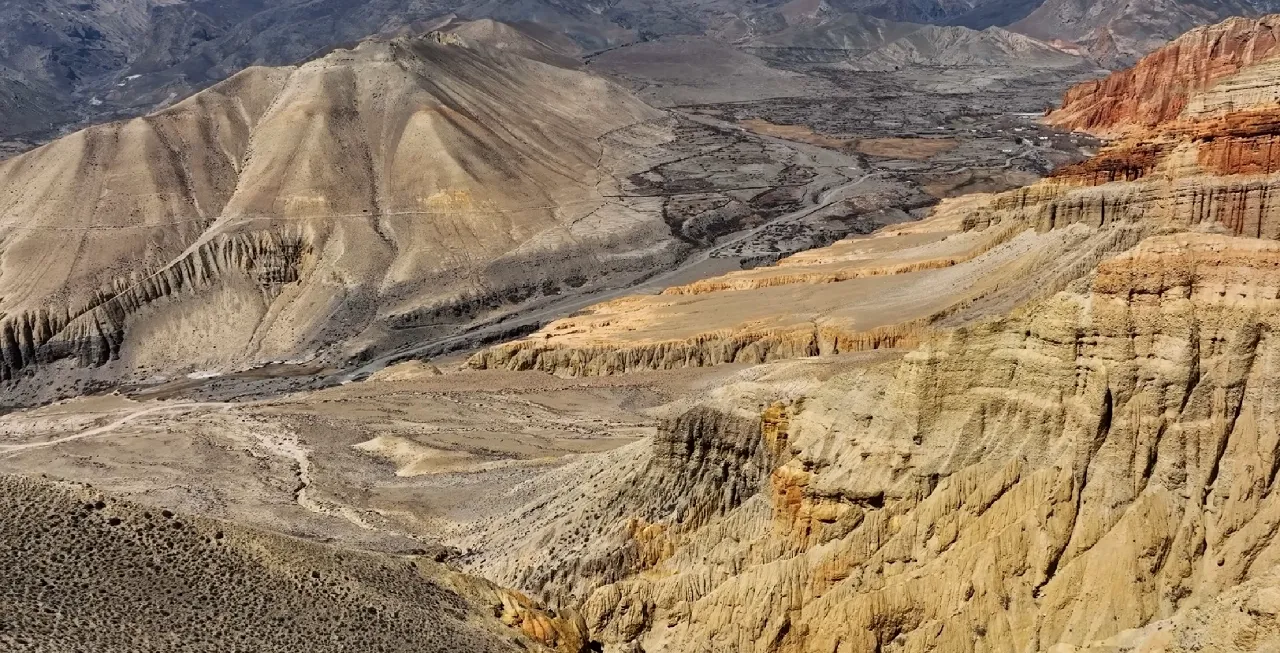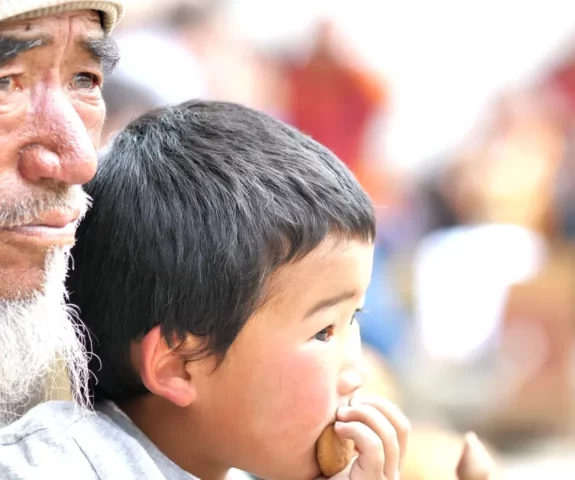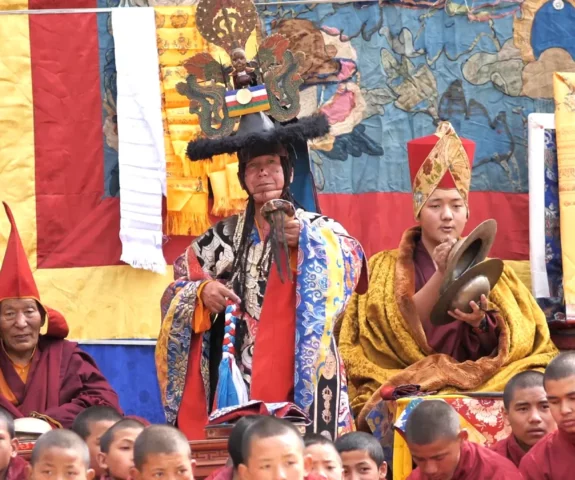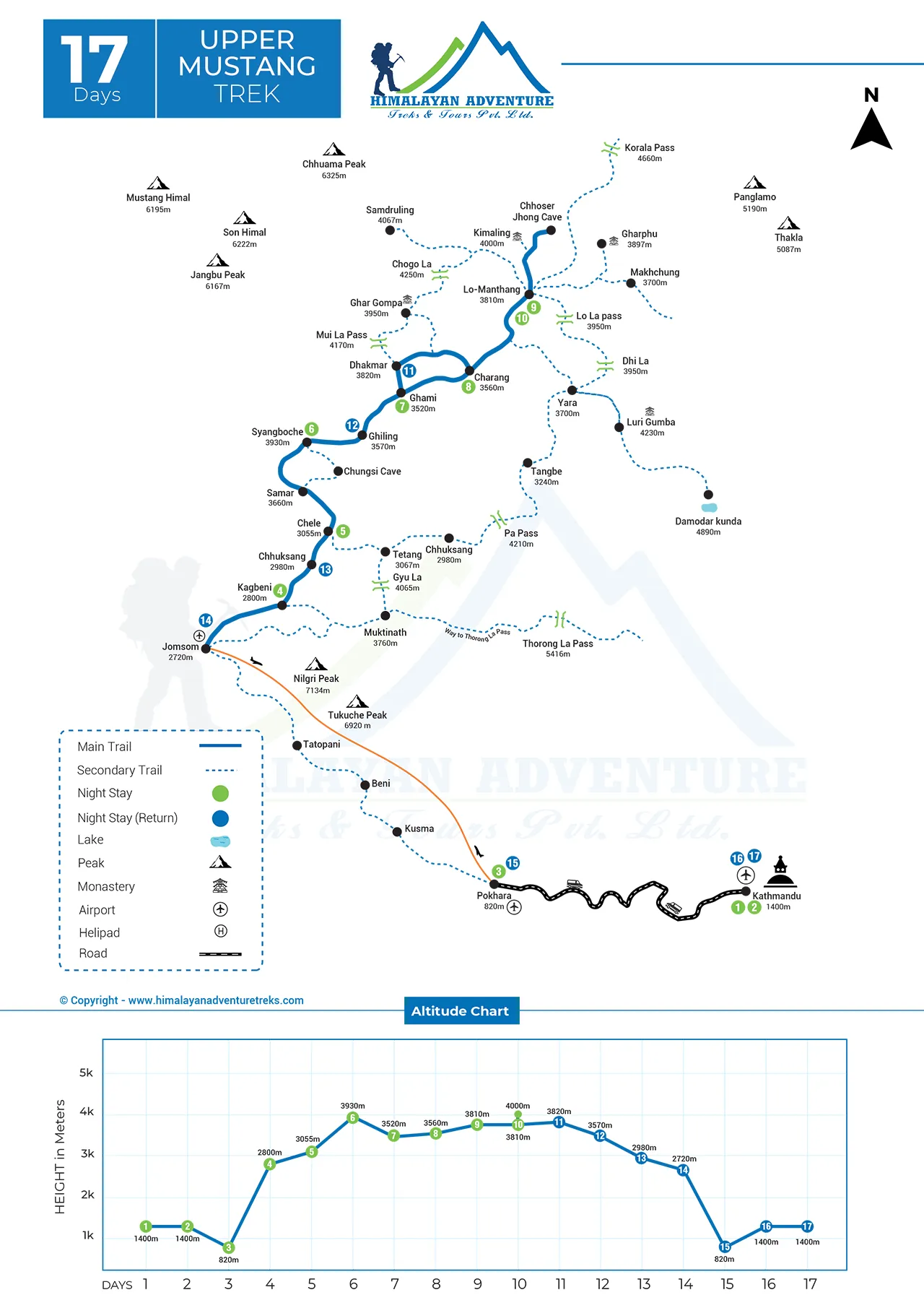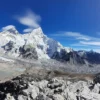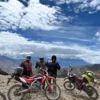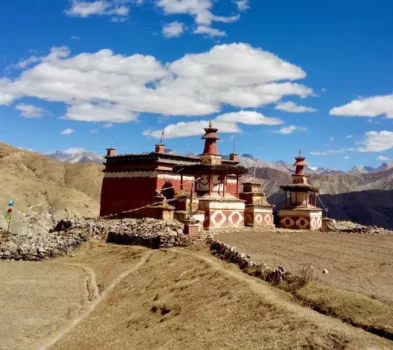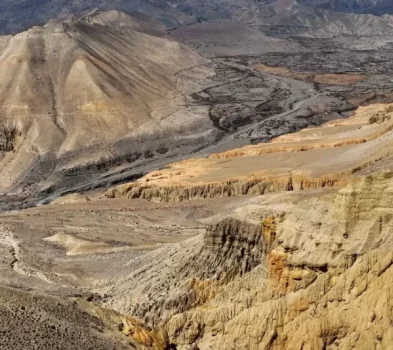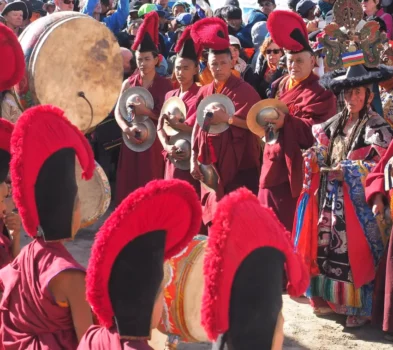Duration
17 DaysUpper Mustang Trek
Trip Grade
ModerateGroup Size
2-16 PeopleMax Altitude
3,860m. / 12,664ft.Best Season
Feb- May/ Sept- NovActivity
Hiking & TrekkingMeals
Breakfast, Lunch & DinnerAccommodation
Hotels & TeahousesTransportation
Private Vehicle, Bus & FlightTrip Customization
On request (click here)Highlights of Upper Mustang Trek
- Discover the hidden gem of the Annapurna region, Upper Mustang.
- Visit ancient caves and monasteries like Chhoser caves and Luri Gompa that reflects the history of the valley.
- Explore the holy site of Muktinath in the Mustang district.
- Experience the diverse cultures of Thakali, Sherpa, and Tibetan people.
Trip Introduction
Upper Mustang Trek is a trending travel destination in Nepal and is revered for its ancient cultural ties. The trek is a great way to know and understand the culture and lifestyle of the Upper Mustang region. Moreover, the views of the Annapurna and Dhaulagiri Himalayas complement the trek very well. Also, the trekking route displays numerous riches of great natural beauty and cultural importance, and the last forbidden Kingdom in Nepal. All in all, this trip offers insight into the Tibetan culture and heritage of the region.
Your arrival in Kathmandu marks the start of the trek. Here, you will spend a day visiting the world heritage sites and preparing for the trek. Then, a drive from Kathmandu to Pokhara will take you halfway across the country. Next, a flight to Jomsom will bring you to the company of Kali Gandaki River. As the trek begins, you walk past numerous villages like Kagbeni, Chhusang, and Geling. Further, the arid trails will lead you to Ghami. Finally, you will take a side trip to Ghar Gompa before reaching Lo Manthang.
In Lo, you can visit the monasteries and relics spread around the village. The Thinggar village and the three great monasteries- Thubchen, Jyampa, and Chodye are also excellent tourist destinations. After exploring the village, you prepare for the return trek and take a detour to the Chhoser caves. These sky caves have been intriguing travelers and archaeologists for ages.
Then, you visit the Luri Gompa and trek to Muktinath Temple. After relishing the religious aroma around the temple, you return to Jomsom. After a flight to Pokhara and a drive to Kathmandu, the trip comes to an end.
Conclusion:
Upper Mustang Trek is a difficult trek, so trekkers need to be in great physical condition. Also, you can opt for this trek in the monsoon as well, since Upper Mustang lies in the rain shadow of the Dhaulagiri Himalayas.
At Himalayan Adventure Treks, we provide great travel services to our clients. Also, we have various other trips and offers for all kinds of travelers. Similarly, our team consists of trained guides, porters, and other staff.
Outline Itinerary of Upper Mustang Trek
Day 01: Arrival at Kathmandu Airport (1400 m)
Day 02: Sightseeing in Kathmandu and Preparation.
Day 03: Drive from Kathmandu to Pokhara.
Day 04: Fly from Pokhara to Jomsom and Trek to Kagbeni.
Day 05: Trek from Kagbeni to Chele.
Day 06: Trek from Chele to Syangboche.
Day 07: Trek from Syangboche to Ghami.
Day 08: Trek from Ghami to Charang.
Day 09: Trek from Charang to Lo Manthang.
Day 10: Day Trip to Chhoser Cave, Lo Manthang.
Day 11: Trek from Lo Manthang to Dhakmar.
Day 12: Trek from Dhakmar to Ghiling.
Day 13: Trek from Ghiling to Chhusang.
Day 14: Trek from Chhusang to Jomsom.
Day 15: Fly from Jomsom to Pokhara.
Day 16: Drive from Pokhara to Kathmandu.
Day 17: Departure to Kathmandu Airport.
Our guests sharing their experiences (Photo/Video Gallery)
Detail itinerary of Upper Mustang Trek
Day 01: Arrival at Kathmandu Airport (1400 m)
Upon arrival at Tribhuvan International Airport, representatives from Himalayan Adventure Treks & Tours will greet you with a warm welcome to Nepal. You’ll be transferred to your hotel in Kathmandu, the vibrant capital city known for its blend of culture and heritage. After some rest, our team will provide a detailed briefing about the Upper Mustang trekking tour and safety measures.
In the evening, you can stroll through Thamel, the most popular area for travelers searching for trekking gear and Nepali cuisine. This first day in Kathmandu sets the tone for an unforgettable Nepal trekking adventure in the Himalayas.
Activity: Airport Pickup, 30 min
Max. Altitude: 1,400m/4,593ft. Kathmandu
Accommodation: Hotel
Day 02: Sightseeing in Kathmandu and Preparation.
After breakfast, we embark on a full-day guided city tour of Kathmandu, covering four iconic UNESCO World Heritage Sites that showcase Nepal’s rich cultural and religious heritage.
1. Pashupatinath Temple
We begin our tour with a visit to Pashupatinath, one of the most sacred Hindu pilgrimage sites dedicated to Lord Shiva. Situated along the Bagmati River, this revered temple is not only a religious site but also a place where Hindu cremation rituals take place, offering deep insights into Nepalese spiritual traditions.
2. Boudhanath Stupa
Next, we visit Boudhanath Stupa, one of the largest Buddhist stupas in Asia and a significant Tibetan Buddhist pilgrimage site. The stupa is surrounded by over 50 Tibetan monasteries (gompas) and vibrant prayer wheels, making it a peaceful yet lively destination where you can witness monks chanting prayers and devotees circumambulating the stupa.
3. Kathmandu Durbar Square
Our journey continues to Kathmandu Durbar Square, an architectural masterpiece that reflects Nepal’s royal history. This historic site was once the royal palace of the Malla and Shah kings and is home to ancient temples, courtyards, and the Kumari Ghar (home of the living goddess, Kumari). The square is a perfect place to explore Newari art, culture, and heritage.
4. Swayambhunath (Monkey Temple)
We conclude our tour at Swayambhunath Stupa, also known as the Monkey Temple, located on a hilltop overlooking the Kathmandu Valley. This ancient Buddhist stupa is a blend of Hindu and Buddhist traditions and offers panoramic views of the city. The presence of playful monkeys, fluttering prayer flags, and spinning prayer wheels adds to the spiritual ambiance of the site.
After an enriching day of sightseeing, we return to the hotel, where you can relax or explore the vibrant streets of Thamel in the evening.
Activity: Sightseeing, 5-6 hours
Max. Altitude: 1,400m/4,593ft. Kathmandu
Meal: Breakfast
Accommodation: Hotel
Day 03: Drive from Kathmandu to Pokhara.
Today, embark on a scenic Kathmandu to Pokhara drive along the Prithvi Highway, one of Nepal’s most beautiful road routes. The journey takes you through terraced hills, roaring rivers, and small rural settlements along the Trishuli River valley. Pokhara, often called the “City of Lakes,” is the gateway to the Annapurna and Mustang trekking regions.
Upon arrival, relax by the peaceful Phewa Lake and enjoy the stunning reflection of the Annapurna range. The road trip is a favorite among those searching for Pokhara tour packages and Nepal scenic drives.
Activity: Drive, 7-8 hours
Max. Altitude: 850m/2,789ft. Pokhara
Meal: Breakfast
Accommodation: Hotel
Day 04: Fly from Pokhara to Jomsom and Trek to Kagbeni.
Activity: Flight & Trek, 3-4 hours
Max. Altitude: 2,800m/9,186ft. Kagbeni
Meal: Breakfast, Lunch & Dinner
Accommodation: Teahouse
Day 05: Trek from Kagbeni to Chele.
The trail from Kagbeni to Chele follows the Kali Gandaki Gorge, passing through the charming villages of Tangbe and Chhusang. You’ll witness whitewashed houses, black and red chortens, and beautiful farmland reflecting the essence of Tibetan culture in Nepal.
As you ascend, the scenery transitions from green hills to the desert-like terrain typical of Upper Mustang trekking routes. Upon reaching Chele, enjoy views of the Nilgiri Himal and surrounding cliffs. The Kagbeni to Chele trek is a remarkable introduction to the mystical Mustang landscape.
Activity: Trek, 5-6 hours
Max. Altitude: 3,049m/10,003ft. Chele
Meal: Breakfast, Lunch & Dinner
Accommodation: Teahouse
Day 06: Trek from Chele to Syangboche.
Today’s journey features several passes, including Taklam La Pass (3624 m) and Dajori La Pass (3735 m), offering breathtaking panoramic views of the Himalayas. The trail winds through rugged cliffs and ancient caves, ideal for adventure enthusiasts searching for Upper Mustang hiking trails.
You’ll pass through small settlements and encounter prayer flags fluttering in the mountain breeze. Arriving at Syangboche, you’ll find peace and solitude amidst the arid Mustang highlands. The day perfectly captures the charm of Chele to Syangboche trekking adventures.
Activity: Trek, 5-6 hours
Max. Altitude: 3,475m/11,401ft. Syngboche
Meal: Breakfast, Lunch & Dinner
Accommodation: Teahouse
Day 07: Trek from Syangboche to Ghami.
The trail ascends gently toward Yamda La Pass (3850 m) before descending through picturesque valleys dotted with Buddhist shrines. As you walk, you’ll notice ancient mani walls carved with Tibetan prayers, symbolizing deep spirituality along the Upper Mustang trekking route.
The red cliffs and barren landscapes resemble scenes from another planet. Ghami village, one of the largest settlements in Mustang, is surrounded by barley fields and traditional mud-brick houses. This stage of the trek showcases the authentic beauty of Upper Mustang culture and lifestyle.
Activity: Trek, 5-6 hours
Max. Altitude: 3,500m/11,483ft. Ghami
Meal: Breakfast, Lunch & Dinner
Accommodation: Teahouse
Day 08: Trek from Ghami to Charang.
Your journey continues along Nepal’s longest mani wall, believed to hold immense spiritual significance. The trail leads you through red and brown cliffs shaped by centuries of wind erosion. Upon reaching Charang, explore the ancient Charang Monastery and the old royal palace, both representing the rich Buddhist heritage of Mustang.
The surrounding valley offers striking views of Nilgiri Himal and the dry Mustang plateau. This part of the trek is highly recommended for those searching for Upper Mustang cultural tours.
Activity: Trek, 4-5 hours
Max. Altitude: 3,560m/11,680ft. Charang
Meal: Breakfast, Lunch, Dinner
Accommodation: Teahouse
Day 09: Trek from Charang to Lo Manthang.
Today’s trek takes you across the Lo La Pass (3950 m), from where the walled city of Lo Manthang, the ancient capital of Mustang, comes into view. Lo Manthang’s whitewashed mud-brick walls and narrow alleys give it a mystical medieval feel. Inside the city, explore centuries-old monasteries, royal residences, and colorful prayer wheels.
The area’s Tibetan-influenced architecture and culture make it one of the most searched Upper Mustang trekking destinations. Reaching Lo Manthang is a highlight of any Mustang trekking itinerary.
Activity: Trek, 5-6 hours
Max. Altitude: 3,770m/12,369ft. Lo Manthang
Meal: Breakfast, Lunch & Dinner
Accommodation: Teahouse
Day 10: Day Trip to Chhoser Cave, Lo Manthang.
Spend the day exploring Chhoser Cave, a complex network of ancient caves carved into the cliffs, used by monks for meditation centuries ago. Visit Nyphu Gompa and Garphu Monastery, two of the oldest religious sites in the Mustang region.
This cultural excursion from Lo Manthang provides insight into Upper Mustang’s Buddhist traditions and ancient civilization. The dramatic landscapes and spiritual ambiance attract travelers seeking Chhoser cave tours and cultural exploration in Nepal. Return to Lo Manthang for an evening stroll through its charming alleys.
Activity: Trek, 5-6 hours
Max. Altitude: 3,770m/12,369ft. Lo-Manthang
Meal: Breakfast, Lunch & Dinner
Accommodation: Teahouse
Day 11: Trek from Lo Manthang to Dhakmar.
Today’s route follows an alternative path through the Marang La Pass (4230 m), offering panoramic Himalayan views. The landscape around Dhakmar is famous for its red cliffs and legends connected to Guru Rinpoche, the founder of Tibetan Buddhism. The trail features numerous caves and sacred chortens that add to the spiritual charm of the Upper Mustang trekking experience.
Overnight at Dhakmar, where you can enjoy a peaceful environment surrounded by dramatic rock formations. Many trekkers rank this as one of the most scenic sections of the Lo Manthang trek.
Activity: Trek, 6-7 hours
Max. Altitude: 3,800m/12,467ft. Dhakmar
Meal: Breakfast, Lunch & Dinner
Accommodation: Teahouse
Day 12: Trek from Dhakmar to Ghiling.
The trek to Ghiling passes through barren hills and traditional Mustang villages, reflecting the region’s unique desert-like ecosystem. The route provides wide vistas of the Dhaulagiri and Nilgiri ranges, making it a favorite among photographers seeking Upper Mustang trekking photography locations. Ghiling is a quiet settlement where you can visit its ancient monastery and observe the simple Himalayan lifestyle.
The stunning sunset view from Ghiling is one of the most beautiful in the Mustang region. This route perfectly embodies the tranquility of Dhakmar to Ghiling trekking trails.
Activity: Trek, 5-6 hours
Max. Altitude: 3,860m/12,664ft. Ghiling
Meal: Breakfast, Lunch & Dinner
Accommodation: Teahouse
Day 13: Trek from Ghiling to Chhusang.
You’ll descend gradually through Samar village, crossing dry riverbeds and rocky terrain typical of the Mustang trekking landscape. The route offers impressive views of canyons, caves, and mountain ridges. Chhusang village sits beautifully near the Kali Gandaki River, offering a mix of Tibetan and Thakali culture.
This day allows trekkers to reconnect with the natural beauty and cultural richness of Lower Mustang. Many travelers searching for Chhusang trekking routes find this section peaceful and scenic.
Activity: Trek, 5-6 hours
Max. Altitude: 3,050m/10,007ft. Chhusang
Meal: Breakfast, Lunch & Dinner
Accommodation: Teahouse
Day 14: Trek from Chhusang to Jomsom.
The final trekking day follows the Kali Gandaki River valley back toward Jomsom, retracing your steps through Kagbeni. The landscape gradually shifts from barren cliffs to greener terrain as you exit the Upper Mustang region. Jomsom, known for its Thakali culture and apple orchards, is a great place to celebrate the completion of your journey.
The day provides the last glimpse of the Upper Mustang desert terrain and Himalayan peaks. This route is popular among those looking for Jomsom trekking itineraries and Mustang experiences.
Activity: Explore, 6-7 hours
Max. Altitude: 2,715m/8,907ft. Jomsom
Meal: Breakfast, Lunch & Dinner
Accommodation: Teahouse
Day 15: Fly from Jomsom to Pokhara.
Take a short morning flight from Jomsom to Pokhara, one of the most scenic domestic flights in Nepal. The aerial view of the Annapurna and Dhaulagiri mountain ranges is truly breathtaking.
Upon arrival, explore Pokhara’s top attractions, including Davis Falls, Gupteshwor Mahadev Cave, and Phewa Lake. Pokhara offers the perfect relaxation after completing your adventurous Upper Mustang trek. Many travelers choose this route for the Jomsom to Pokhara flight experiences and lakeside leisure.
Activity: Fly, 20 min
Max. Altitude: 830m/2,723ft. Pokhara
Meal: Breakfast
Accommodation: Hotel
Day 16: Drive from Pokhara to Kathmandu.
After breakfast, enjoy a scenic Pokhara to Kathmandu drive along the same highway filled with river valleys and traditional Nepali villages. You’ll arrive in Kathmandu by late afternoon and transfer to your hotel.
In the evening, Himalayan Adventure Treks & Tours will host a special farewell dinner with Nepali cultural dance to celebrate your successful journey. Share your experiences of the incredible Upper Mustang trekking adventure with your guides and team. This warm farewell is a highlight of many Nepal trekking tour packages.
Activity: Drive, 7-8 hours
Max. Altitude: 1,400m/4,593ft. Kathmandu
Meal: Breakfast & Dinner
Accommodation: Hotel
Day 17: Departure to Kathmandu Airport.
After breakfast, our representative will transfer you to Tribhuvan International Airport for your final departure. As you leave Nepal, you’ll carry unforgettable memories of your Upper Mustang trek and the warm hospitality of the Nepali people.
The journey back home will be filled with stories of adventure, culture, and Himalayan beauty. We hope to welcome you again for another Nepal trekking and cultural tour in the near future.
Activity: Airport drop, 30 min
Max. Altitude: 1,400m/4,593ft. Kathmandu
Meal: Breakfast
Note:
If you have your own private group and want to make your trip private, we can run the custom trip all the day as per your requirements and group size.
Includes and Excludes
What are included with package?
- Airport Pick-drop and Transfer to the hotel: Arrival and departure transfers by private vehicle are included.
- Three Night 3-star hotel in Kathmandu with Breakfast: Stay in a 3-star hotel with breakfast in Kathmandu.
- Two Night 3-star hotel in Pokhara with Breakfast: Stay in a 3-star hotel with breakfast in Pokhara.
- Kathmandu sightseeing by private vehicle with an experienced tour guide: Private vehicle and professional guide for sightseeing in Kathmandu.
- Flight from Pokhara to Jomsom and Pokhara: Flight tickets for domestic travel between Pokhara and Jomsom are included.
- Your standard meals (Breakfast, Lunch, and Dinner) during the trek: Meals provided during the trek.
- Kathmandu to Pokhara and Kathmandu by tourist bus: Bus transportation between Kathmandu and Pokhara is included.
- Upper Mustang special permit: The necessary special permit for Upper Mustang is included.
- All necessary paperwork: All paperwork required for permits and logistics will be handled.
- All accommodations in tea houses during the treks: Accommodation in tea houses along the trekking route.
- ‘Trekkers’ Information Management System (TIMS) Permit: The TIMS permit for trekkers is included.
- Trekking Permit (ACAP): The Annapurna Conservation Area Permit is included.
- An experienced, helpful, Government-licensed holder and friendly Guide, porters (1 porter for 2 clients): A licensed guide and porters (1 for 2 clients) for your trekking journey.
- Medical supplies (first aid kit will be available): A first aid kit will be available during the trek.
- All government taxes: Government taxes and fees are included.
- Last Night’s farewell dinner at an authentic Nepalese restaurant with a cultural performance: A farewell dinner with cultural entertainment is included.
What are not included with package?
- Nepal Visa fee: You may obtain your Nepal visa easily upon arrival at Kathmandu airport.
- International airfare to and from Kathmandu: Flight tickets to and from Kathmandu are not included.
- Entrance fee in Kathmandu: The entrance fee for monuments and cultural sites in Kathmandu is not included.
- Extra night Hotel accommodation in Kathmandu & Pokhara: If you arrive early, depart late, or return early from the trek, the cost of extra nights in Kathmandu will not be included.
- All meals in Kathmandu and Pokhara: Meals in Kathmandu and Pokhara (except those provided during the trek) are not included. This also applies in case of an early return from the mountain.
- Travel and rescue insurance: Travel and rescue insurance is not included and is highly recommended.
- Personal expenses: Expenses such as phone calls, laundry, bar bills, battery recharge, extra porters, bottled or boiled water, shower, and any other personal costs will be your responsibility.
Pick Your Suitable Date
Book a Private Trip
Private & Group Discount Price
-
2 -
2 people
US$ 2000
-
3 -
5 people
US$ 1900
-
6 -
10 people
US$ 1800
-
11 -
15 people
US$ 1700
-
16 + people
9999
US$ 1600
Total Cost:
US$
Route Map & Altitude Chart
Kathmandu
Start/End point
Kathmandu
Trip Information
Entrance fees of Heritage Sites of Nepal:
Nepal is famous for world heritage sites, Tourist attractions places, and monuments areas. Tourism is the second income source of the country. Entrance fees, National park fees, climbing royalties are the backbone of the Nepalese economy. Foreigner tourists visiting heritage sites, attraction places, and monuments of the country and have to pay a certain entrance fee to get inside the area.
The people of South Asian countries (SAARC) have to pay fewer entrance fees in comparison to tourists from other countries. Many tourists want to see the typical Nepalese art and cultural places, happily paying the entrance fee because it is worth paying to visit.
The 7 heritage sites of Kathmandu valley are amazing. Boudhanath, Pashupatinath, Swayambhunath, Kathmandu Durbar Square, Patan Durbar Square, Bhaktapur Durbar Square, and Changunarayan have their own history. They are not only rich in art and architecture but also fountain spiritual places of Hinduism and Buddhism. Most of the constructions made have a tantric background and old history.
Not only the Kathmandu valley but other parts of the country are also rich in nature and history. Lumbini (Birth Place of Gautam Buddha) Chitwan National park, Pokhara, Nagarkot, Trekking trails, Peak climbing, Expedition are the main tourist destination in Nepal and main income sources of the country. It is the government that keeps the price of priceless monuments and makes some money from tourists who visit them.
Please find the attached PDF file for the Entrance fees of World heritage and other attraction places in Nepal.
Entrance Fees of UNESCO World Heritage Sites in Nepal
Physical Fitness:
Many people have questions as to what level of physical fitness is required for trekking in Nepal and that is extremely reliant on what activity the visitor is engaging in Nepal With that said, for a standard easy trek to Extreme hard level of trekking. The daily activity (trek) would be 5-6 hours,(depend on the trekking trail) and elevation will generally not exceed 5,600 meters like Everest Base Camp, Throng la passes, Chola passes treks and other passes or Base Camp but some of them are less than 4000m.
The trekking day is involving both long steep climbs, and descents with a variety of terrain underfoot from well-trodden paths, to rocks covered with ice or snow, depending on the season. Mostly a day would include a number of climbs or descents of 600 meters more or less, starting after the early morning breakfast, resting at a lunch place in the afternoon, then continuous trekking until arriving at the teahouse.
In preparation for the trekking in Nepal, it is important, to begin with, the basic training requirement at least 2 months before departing for trekking in Nepal. Two to three hours of aerobic exercise like running, walking, swimming, cycling & some gym work per week is the minimum and most will find it beneficial to add some basic strength training to their physical fitness routine required for the hard trekking and for normal and easy trek just have some physical fitness is enough.
One of the best ways to prepare is to take practice hikes with a daypack roughly the same weight as what you will be taking during the trek. Your calf should be enough fit and prepare for trekking. Mostly during the trekking calf pain or tiredness is the main issue. Do this only after a baseline of fitness has been reached. Moving fast is not our goal, will provide a more enjoyable and safe adventure trekking in Nepal for all easy and hard level.
Trekking Seasons in Nepal:
There are main two seasons in which Nepal where the most amount of visitors visit. (September, October & November) being the most popular season which is also called the peak season in Nepal, and spring (March, April & May) coming in close behind which is also called the mini-season in Nepal.
The summer months of June, July, and August are the monsoon season and most of the time raining as such the trails are mostly washed out sometimes, and roads can sometimes be impassible due to landslide activates. Nevertheless, you can trek to rain-shadow regions like Upper Dolpo and Upper Mustang during the monsoon seasons. Nepal is a suitable destination for all seasons.
Winter is very dry & extremely cold and all the high passes become inaccessible due to ice and snow conditions. The temperature doesn’t usually fluctuate during the day time temperature is around 20-25 degrees. However, you gain altitude the temperature decreases. The temperature can drop to around 0 to -25 degrees at night when staying at tented camps in Himalayan regions.
Winter trek in higher altitudes is not advised due to the danger of avalanches and also altitude sickness. Although some may enjoy the sight of the snow-covered mountains as you reach your destination. However, the temperature does not change as much in lower mountain regions the nights are slightly colder than days’ time.
Autumn & Spring is the best timing for trekking in Nepal because the weather is generally warm and dry, and flowers are in bloom in the lower elevations of the country on the same time you can see the many festivals during that period.
Trekking Day:
A typical trekking day begins with the early morning breakfast around 7 am in the hotel. (Depend on the trekking region). It would advise you to pack your trekking gears in a duffle bag and essential supplies in your day pack after having breakfast; we begin the trek and head along the trail at around 8 am. The morning walk is more energetic to be longer as we begin with refreshed bodies and enthusiasm.
A good morning’s walk, we make a stop for lunch at around 11-12 pm. The lunch involves group meals enjoying the vicinity around the stop & enjoys the organic & local food in the mountain. After resting for about an hour or two, we resume our trek to reach the teahouse or camp by 2-3 pm. The afternoon walk is relatively shorter and can involve games and side trips as organized by the trekking experienced guides.
You also can enjoy breaks during the trek to relax, read, and stroll around the area, or doing yoga. You can explore with the local people and observe their lifestyle & culture. Dinner is served around 7-8 in the evening to round off the day.
Meals and Accommodations:
During the trekking period, the accommodation is commonly referred to as teahouses. These are family-run basic lodges that fill the role of the restaurant, Dining hall, and boarding house for tourists. Now a day’s electricity can be found in the rooms, which means one light bulb, and one or two outlets for charging electronics. The common areas are also lit by electricity.
Alternatively, teahouses may also use solar, hydroelectric, or have electrical lines running into the village, so the commonality and availability of electricity may vary. Still, a few of the trekking route electricity service is not available. Use the local traditional kerosene light.
Most of the teahouses have private rooms, though if the trek is in a more remote or high altitude place there are limited teahouses so season time dormitories are the norm. Most of the room has 2 single beds with basic bedding, and the bathroom is shared. Some of the places we can get the private bathroom also with a mix of western and squat style toilets in the bathrooms.
Breakfast and dinner are taken at the same teahouses and these lodges have large family-style dining rooms centered on a stove or coal to provide heat basically in mountain areas. Most of the area’s menu will have Nepali-style western foods such as pancakes, pizza, burgers, fries, etc. Also on the menu is the traditional Nepali food Dal Bhat meal. This is a lentil soup with rice, vegetable, Pickle, or meat curry. Most menus will also offer a smattering of local cuisine.
Internal Flight Delays:
Nepal is an incredible and beautiful country of mixed of the White Mountains, deep valleys, Landscape, rivers, and green rolling hills. With this incredible diversity of landscapes, road travel can be extremely time-consuming and flights within Nepal to reach popular trekking destinations is the easiest way. Not all the trekking destination has flight service, so road transportation is the only option.
Mountainous terrain also comes with the possibility of in-climate weather. It mentions the incredibly high number of visitors during peak seasons makes internal flight delays a genuine possibility. To manage this situation, it may be helpful to have a few extras days on either end of your tour. If any cancellations or flight delays do occur (high chances of flight delays from around Kathmandu to Lukla, Everest region, Pokhara to Jomsom, Annapurna region), we also provide services to arrange chopper on the last stage to help you to be on your schedule on the premises of Civil Aviation Rules in Nepal which state that helicopters can fly if the visibility is 1500m.
The cost ranges from USD400 to USD650 according to the number of passengers. The payment can be made either to the helicopter company or to us directly and can be made either by cash or using a credit card. It will be beneficial to purchase and review your insurance, the insurance companies may cover some of the alternative measures of travel. Flight insurance may cover changing your international flight if it is necessary.
Travel Insurance:
Most expeditions, Adventurous trekking, and tours require that travel insurance, and it is purchased prior to arriving in Nepal, but other normal treks and tours may not require it. However, travel insurance is definitely an important consideration. There are a number of reasons to consider insurance. Firstly, it may be required, so check to see what is being asked for by the company.
Second, Nepal is a landlocked country, and there are only a few direct flights. Travel in and out of the country can encounter some disruptions if purchasing insurance, make sure flight delays and cancellations also included. Always choose insurance that, though every safeguard is in place during your Holiday, there are always extenuating circumstances that may result in an accident during trekking & tours.
Read printout of insurance policies carefully to ensure that the trekking or any other activity you are engaging in is covered or not, as some policies have stopped covering trekking in certain places. If you are going above 5000 m or high always mention the policies, so it’s cover the chopper service in the last condition. It is vital that if you have the comfort of good insurance, so do the research and choose carefully, which makes your trip relaxing and joyful.
Nepal Visa Entry Procedure:
There is only one International airport which is the Tribhuvan International Airport in Nepal. Immigration Office, TIA (Tribhuvan International Airport) under the Department of Immigration has been facilitating tourists flying to Nepal by providing visas on Arrival.
‘On Arrival’ visa procedure is very quick and simple. October, November, March, April can expect some queues during peak Tourist season and October is basically the Nepalese got the Main festival Dashain. You can also get Visa from Nepalese Diplomatic Missions stationed abroad prior to your arrival. The choice is yours.
Visa obtains from Nepalese Diplomatic Missions, and then you must enter Nepal within six months from the visa issued date. Your total stay is counted starting from the day you enter Nepal.
Visas obtained on Arrival at the Entry and Exit points are ‘Tourist Visas’. They bear multiple Re entry facilities. Tourist Visa ‘On Arrival’ is the only entry visa to Nepal. If you are visiting Nepal for purposes other than Tourism (sightseeing, tour, travel, mountaineering, trekking, visiting friends and families), you should still get a ‘Tourist Visa’ to get into the country. However, you must change the category of visa as per your purpose and length of stay in Nepal from the Department of Immigration by producing the required documents.
Please click below for the online Visa form.
http://online.nepalimmigration.gov.np/tourist-visa
The following visa rules apply for tourists:
- For 15 days Multiple Entry Visa, the visa fee US $30 or equivalent foreign currency.
- For 30 days Multiple Entry Visa, the visa fee US $ 40 or equivalent foreign currency.
- For 100 days Multiple Entry Visa, the visa fee US $ 100 or equivalent foreign currency.
According to the immigration regulations, a tourist is allowed to stay in Nepal only for 150 days a year. You can extend the visa up to another 90 days.
US$ 2 or equivalent Nepalese currency per day for extension.
Additional US$ 25 or equivalent Nepalese currency on visa fee, if Multiple Entry facility is required for the extended period
For more details please visit our FAQ link
https://www.himalayanadventuretreks.com/faq/
Acute Mountain Sickness (AMS):
Acute Mountain Sickness (AMS) is usually seen in un-acclimatized people shortly after ascent to high altitudes. The condition occurs due to the thinning of air as the altitude increases. The condition, if not taken seriously and treated immediately, can be life-threatening and its symptoms can be seen generally above 3200 meters. The symptoms of Acute Mountain Sickness are nausea, vomiting, tiredness, shortness of breath, and cerebral pain.
The itineraries are designed to properly acclimatize you to the change in high altitude climate and sufficient precautionary measures too are taken to take utmost caution for our valuable guests. Our staff also equipped with cell phones and satellite phones (Option) in the occurrence of any emergency cases. We are greatly driven to keep the safety and security of our clients as our foremost concern.
Drinking-Water:
Water is essential for life, and clean water is imperative while on holiday. When visiting less developed countries like Nepal it is a concern that all travelers should consider. There are few options when trekking or traveling in Nepal that will mitigate any chances of drinking contaminated water. The first consideration to take into account is that tap water should not be ingested. That even means when brushing your teeth in an urban area.
Most will choose to buy bottled water and if doing so make sure the cap has sealed properly. Plastic bottle reuse is a big problem, and with that being said there are other options on the market to assist in making water drinkable. Mountain spring water is drinkable but if you use the purified tablet. The conservation area project also sells this tablet for most of the trekking area. A guide will assist you to find out it also.
Arrival Instruction:
Upon your arrival at Tribhuvan International Airport (TIA) Kathmandu Nepal, our company representatives are stationed to welcome you to the country. We request you to carefully look for your and company name placard being held by our representatives following the events upon landing. Our representatives will be responsible to escort you up to your hotel in Kathmandu. There are many brokers, Taxi drivers, and trouble maker people offering you to carry your luggage and take you to your destination as you exit from the gate. We request you to pay no attention to these people and follow the company representatives and follow their instructions.
How to Book Your Tour:
Before booking any tour or trekking please read all the terms and conditions thoroughly and call or email the company representative with any questions prior to making any payments. Begin by filling out a booking form and pay the non-refundable deposit. Fill out the form completely and if any confusion contacts the company person so as not to disrupt the expediency of the process. The form may be submitted online or by downloading the form and mailing or Whatsapp the form to your company representative.
It is very important to understand all aspects of the chosen trip, from what’s included and excluded, to the level of service, or even what trip may be right for your level of experience and fitness. Take the time to get all the questions answered so that when booking the trip, it is without trepidation.
Equipment List for Upper Mustang Trek:
Upper Mustang is difficult trekking but however our long-year experience of operating Trekking to Nepal, We learn many things and would like to give some information to pack your equipment list for your Trekking and we hope, this information will be helpful you so success your trip.
Luggage/Duffle bag:
You will require a duffel bag or a backpack for trekking (65- 75 L) max, and all our trekking stuff is kept in this duffle bag, and our porters will carry this. However, Himalayan Adventure also provides the duffle back if needed.
A day backpack:
You will need a day backpack and you will be carrying it every day by yourself and we recommend you it has to be at least 25L and you can carry important documents like Passport, credit card along with a need to carry a water bottle, snacks bar and clothing layers (hat, gloves, fleece, sunblock, poles, etc…).
Trekking/Hiking boots:
Upper Mustang is difficult to trek, and It is essential to have good trekking boots, and it should be waterproof (in case of snow, or rain) Make sure it should be fit on your feet and comfortable during walking. Also, recommend you bring the Crompton during the winter season in Nepal.
Sport Sandals:
You need to have a pair of sports shoes or sandals to use while you are in camp or tea houses after the trek.
Sneakers:
Upper Mustang is difficult trekking so sneakers are not suitable for this trek so you can leave your sneakers in the Kathmandu hotel until you get back.
Sleeping Bag:
You need to have a lightweight sleeping bag that works for minus 15 degrees for the summer season but during the winter we recommend minus 20 degrees for the trekking. Himalayan Adventure can provide it if you need one but has to be returned after the trek.
Fleece jacket:
You need to have good quality fleece jacket at least 1 synthetic jacket or pullovers are a great alternative to fleece because they are lighter and more compressible and gives you enough warmth during trekking.
Down jacket:
Down jacket is compulsory and recommends you to bring the warm enough so can keep you warm during the Trek.
Socks:
You need to have at least 5 pairs of thick socks during the spring & autumn but winter and monsoon need at least 7 pairs of socks for this trekking.
Lightweight/ warm insulated pants:
You need to have at least 3 pairs of lightweight trekking pants like Lightweight expedition thermal bottoms, Nylon hiking shorts, Softshell and hardshell trekking pants, Water/windproof trousers, and Casual pants so we can use them like the weather.
Short-sleeved shirts:
You need to have 3 ice-breaker merino wool to keep you warm from the cold or synthetic shirts and if you are not allergic to wool products, merino wool is ideal for Upper Mustang Trek & Himalayan Adventure also provide the 1 company T-shirt as a souvenir.
Long-sleeved shirts:
You need to have at least three shirts.
Underwear:
You need to have few pairs of underwear and this can be as much as you need as there are no washing facilities every day on Upper Mustang Trek so, we highly recommend you to have enough pair of underwear.
Waterproof jacket:
You need at least one waterproof jacket for the rain/snow and wind for the Upper Mustang Trek and waterproof pants may be an option.
Head and face gear:
Sun Hat or cap during the daytime, Woolen Hat for morning & Evening, and Polarized sunglasses are compulsory.
Hand gear:
You need warm gloves.
Traveling supplies:
Adapter Plug for Charging the Camera and Mobile, Camera belt, Passport belt ( nice to have), Swiss army knife (option), Flashlight, Headlamp, Water bottle, Extra camera battery, Hand sanitizer, Alarm clock, Hiking poles (optional ), and Binoculars (optional).
Toiletries:
Razor, razor blades, shaving cream, aftershave toothbrush, toothpaste, dental floss, sunscreen, toilet paper, small towel, and period pads (for women).
Medication:
First Aid Medical Kit box (can be purchased in Thamel Kathmandu), Altitude Medicines (Diamox), Tylenol, aspirin, ibuprofen, Anti-diarrheic, Powerful antibiotics, and Nasal Spray or Drops.
Essential Packing Gear List for Upper Mustang Trek
If you have decided to go on the Forbidden Kingdom trek, Upper Mustang Trek in Nepal, we assure you that you will have a fantastic time ahead. But what should you pack for your Adventure? What will be the right gear to make your trip more fabulous? To help you with this, we have compiled a packing list of essential items that you mustn’t forget to bring along.
- Passport ( min 6 months valid)
- Cash, credit card
- List of important addresses and contact details
- 2-3 passport photos (optional)
- Copies of all important travel documents (passport, visa, airline ticket, insurance policy, etc.)
- A sturdy 70 L trekking backpack which will be carried by your porter (please note that our assigned 1 porter will carry 2 clients’ luggage up to 20-25 kg.
Note: We will provide each participant with a spacious 70 to 75 L Company logo duffle bag to conveniently carry your trekking gear, which you have to return once the trek is complete. - A 30 L Daypack that has room for your essentials such as camera, mobile, Passport, important documents, water bottle, day-useable medicine, chocolate bars, raincoat, etc., which will be carried by you.
- Protective cover for a backpack or travel bag.
- Hiking Boots: Preferably ankle-high boots to prevent ankle sprain
- Regular Shoes: For small strolls and exploration around the city
- Crampons: During the winter, December- March
- Second, a light pair of shoes and possibly sandals
- Micro Spikes or Ice Cleats for the winter trekking over snow and ice
- Gaiter for added protection in snow
- A rain and wind-resistant, lightweight down jacket for warmth, with a good helmet hood
- Summer-light, as well as winter warm clothing
- Quick-drying shirts made of synthetic fabrics
- Warm and cool vests or T-shirts
- Functional synthetic underwear
- Sports Bra for Female Trekker
- A waterproof pair of trousers
- Regular trousers of quick-drying fabric
- Hiking shorts
- Cargo Pants with multiple pockets to hold your small items, such as knives or chocolates
- Woolen or fleece pants
- Trekking socks, both thick and woolen fabric, and lighter wool socks
- Wool hat, gloves, and scarf
- A light cotton scarf or a bandanna for protection of your head, neck, ears, and mouth
- Sun hat, and sunglasses with 100% UV protection (for trekking trips, even with stray light and nose protection)
- Sunscreen cream or lotion with a high sun protection factor (at least 15, for trekking trip,s even at least 30)
- Sunscreen lipstick with a high SPF (at least 20, for trekking trips, even at least 30 or sunblock)
- Mosquito repellent (Optional)
- Comfortable light night clothes and shoes
- A drinking bottle that can be used as a hot water bottle on frosty nights
- Flip-flops or bathing shoes for using the showers
- Water purifiers: if you need to refill water from the tap or stream en route
- Headlamp: for a midnight or pre-dawn trip towards the viewpoint
- Quick-drying towel and sample-size toiletries for washing your feet and face
- Your Personal first-aid kit: with basic medical supplies such as bandages for sprains, antidiarrheal and antibiotics, iodine wipes for scrapes and cuts, plasters, aspirin, or ibuprofen, moleskine for preventing blisters, Diamox (acclimatizing medicine), and your Personal medication
- Sleeping bag appropriate for all-season treks (we can hire in Kathmandu)
- Waterproof money belt, chest bag, leg bag, or belt bag for storing important travel documents or valuables
- Toothpaste, Toothbrush, and soap
- Deodorants
- Moisturizer
- Nail clippers
- Feminine hygiene products (Sanitary Pads)
- Small mirror
- Wet wipes
- Hand sanitizer
- Comb
- Camera with sufficient memory cards and spare batteries, or a battery charger
- Small padlock for your travel bag
- Crampons ( during winter, Dec- Feb)
- Thermos flask
- Water bag
- Toilet paper (2-3 rolls without)
- Ear Plugs
- Matchbox, or lighter
- Compass or GPS
- Map
- Alarm clock
- Multi-tool kit
- Binoculars
- Books
- Whistle
Equipment Note:
- Please note that there is no need for you to bring all these heavy items, such as a Sleeping bag, a down Jacket, Trekking Poles, and items from your home. You can easily rent or purchase high-quality to standard-quality items in Kathmandu and Pokhara.
- Items are available from international brands such as The North Face, Sherpa Adventure, Marmot, Mountain Hardware, Black Yak, Karma Gear, and local brands like Goldstar and locally made products etc.
- Plus, we will also gift you a company logo T-shirt as a token of your experience in Nepal with us.
Renting Cost:
- Sleeping Bag & Down Jacket (-10-20 degree Celsius), Per Piece per day US$ 1.5
Frequently Asked Questions
What is the Upper Mustang Trek and why is it popular?
The Upper Mustang Trek is a remote and culturally rich trekking route in Nepal’s Trans-Himalayan region, often referred to as the “Last Forbidden Kingdom.” It offers rare insight into Tibetan culture, ancient monasteries, sky caves, and dramatic desert-like landscapes unlike anywhere else in Nepal. This trek is increasingly popular in searches like “Upper Mustang Trek Nepal” and “forbidden kingdom trek Nepal”.
How long does the Upper Mustang Trek take and what is the typical itinerary?
The trek usually takes 14 to 17 days, starting from Kathmandu, driving to Pokhara, flying to Jomsom, and trekking through Kagbeni, Ghami, Lo Manthang, and Muktinath. Major highlights include Lo Manthang, Chhoser sky caves, and Luri Gompa. This is a commonly searched topic under “Upper Mustang Trek itinerary” and “Mustang trekking route”.
What permits are required for the Upper Mustang Trek?
You need the following permits:
-
Restricted Area Permit (RAP): USD 500 per person for the first 10 days, and USD 50 for each additional day.
-
Annapurna Conservation Area Permit (ACAP): NPR 3,000 (approx. USD 25).
You must also trek with a licensed guide and be in a group of two or more. This is often searched as “Upper Mustang trek permit cost” and “How to get Mustang permit?”
What is special about Lo Manthang, the capital of Upper Mustang?
Lo Manthang is the walled capital of Upper Mustang and a cultural treasure trove with ancient monasteries, royal palaces, and Buddhist relics. It’s home to Thubchen, Chodye, and Jampa monasteries, and lies near Chhoser’s sky caves. The area is frequently searched under “Lo Manthang Mustang Nepal” and “what to see in Lo Manthang”.
What are the sky caves of Mustang and can they be visited during the trek?
Yes, the Chhoser sky caves near Lo Manthang are accessible on a side trip. These man-made caves are carved into cliffs and are believed to be over 2,000 years old, used for meditation, burial, and storage. They are among the most searched elements under “Mustang sky caves Nepal” and “Chhoser cave exploration”.
When is the best time to do the Upper Mustang Trek?
The best seasons are spring (March to May) and autumn (September to November). However, Upper Mustang lies in a rain-shadow zone, making it one of the few treks possible even during the monsoon (June to August). Many trekkers search “best time to trek Upper Mustang” and “Can I trek Mustang in monsoon?”.
How difficult is the Upper Mustang Trek?
The trek is moderately difficult. It does not involve high passes like in other regions but still reaches altitudes over 3,800 meters. Trekkers should be in good physical condition and prepared for long walking days and dry, windy conditions. Searches often include “Upper Mustang trek difficulty level” and “Is Upper Mustang suitable for beginners?”
What kind of cultural experience can I expect during the Upper Mustang Trek?
Upper Mustang is a cultural extension of Tibet, where Tibetan Buddhism is widely practiced. You’ll witness monastic life, local festivals, Chortens, and ancient caves. Visiting places like Luri Gompa and Thubchen Monastery allows you to deeply connect with the Tibetan culture in Nepal, often searched under “Tibetan culture trek Nepal”.
Is the Upper Mustang Trek a teahouse trek or a camping trek?
Today, the Upper Mustang Trek is mostly a teahouse trek, with basic but comfortable accommodation available in villages like Kagbeni, Geling, Lo Manthang, and Ghami. Camping is optional but not necessary for most trekkers. Frequently searched terms include “Upper Mustang trek accommodation” and “Is camping required in Mustang?”
How do I get to the starting point of the Upper Mustang Trek?
You travel from Kathmandu to Pokhara by road or flight, then take a scenic flight to Jomsom. From Jomsom, the trek begins with a hike to Kagbeni, the gateway to Upper Mustang. This logistical route is often searched under “How to reach Upper Mustang” and “Jomsom to Lo Manthang trek route”.

